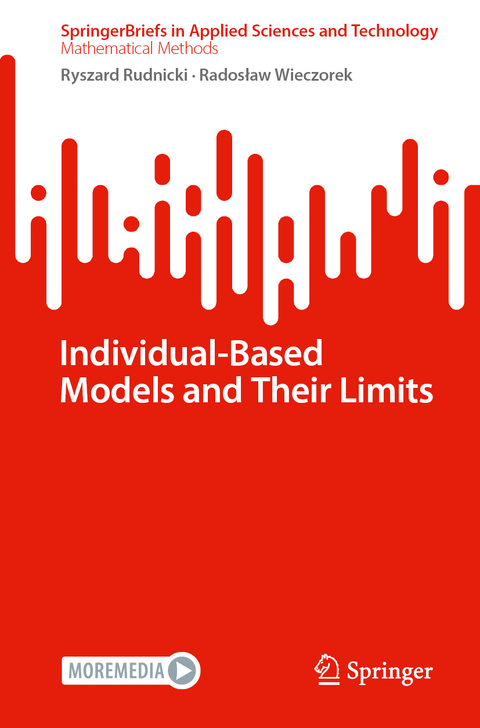
Individual-Based Models and Their Limits
Springer International Publishing (Verlag)
9783031752698 (ISBN)
Individual-based models (IBM) describe a population as a collection of different organisms whose local interactions determine the behaviour of the entire population. The individual description is convenient for computer simulations and the determination of various model parameters, and appropriate limit passages lead to the transport equations used in classical population dynamics models. The aim of this book is to provide a brief mathematical introduction to IBMs and their application to selected biological topics. The book is divided into seven chapters. In the first chapter we give a general description of IBMs and we present examples of models to illustrate their possible applications. Examples of applications include age, size and phenotype models, coagulation-fragmentation process, and models of genome evolution. The second chapter contains some theoretical results concerning limit passages from IBMs to phenotype and age-structured models. The rate of this convergence formulated as functional central limit theorems is presented in Chapter 3. As a result of the limit passage can be a superprocess, i.e., a stochastic process with values in a space of measures. Chapter 4 presented examples of such passages: from the branching Brownian motion to the Dawson--Watanabe superprocess and from the Moran's model of genetic drift with mutations to the Fleming--Viot superprocess. The next three chapters are devoted to models, in which we directly participated in the study. In Chapter 5 we study IBMs phenotype models and their limit passages. We show that random mating stabilises the distribution of traits, while assortative mating can lead to a polymorphic population. Formation of aggregates of phytoplankton and their movement is studied in Chapter 6. We present two types of models based on: fragmentation-coagulation processes; and diffusion with chemical signals leading to advanced superprocesses. Chapter 7 is devoted to rather advanced models with chemotaxis used to description of retinal angiogenesis and cell proliferations. The book is complemented by two appendices in which we have collected information about stochastic processes and various spaces we have used. The book is dedicated both to mathematicians and biologists. The first group will find here new biological models which leads to interesting and often new mathematical questions. Biologists can observe how to include seemingly different biological processes into a unified mathematical theory and deduce from this theory interesting biological conclusions. Apart from the sections on superprocesses, where quite advanced mathematical issues arise, such as stochastic partial equations, we try to keep the required mathematical and biological background to a minimum so that the topics are accessible to students.
Ryszard Rudnicki, born in 1957, holds an M.Sc. in Mathematics (1980), a Ph.D. (1987), and a Habilitation (1993) from the University of Silesia, Katowice, Poland. He was awarded the scientific title of Professor in 2001 by the Institute of Mathematics of the Polish Academy of Sciences (IMPAS). He currently serves as a Full Professor, the Head of the Katowice Branch of IMPAS, and the Vice-Director of the Mathematical Center for Applications in Science and Technology at IMPAS.
From 1980 to 2012, he worked in the Department of Mathematics at the University of Silesia, Katowice. His professional interests include biomathematics, dynamical systems, stochastic processes, and differential equations. He has authored 100 scientific papers, most of which focus on the application of mathematics to biological problems. He has also written four books, including the monograph Piecewise Deterministic Processes in Biological Models (Springer, 2017) with M. Tyran-Kaminska, published in the same series as his proposed book. Several of his papers focus on Individual-Based Models and limit theorems.
Radoslaw Wieczorek is an adjunct professor at the Institute of Mathematics, University of Silesia in Katowice. He graduated both mathematics and physics, but chose to work in biomathematics and got his PhD for the research on fragmentation-coagulation models of phytoplankton at the Institute of Mathematics of Polish Academy of Sciences. His research interests focus on individual-based stochastic processes, especially applied to biological phenomena. He has written a number of papers concerning convergence of the individual-based models.
- 1. Models.- 2. Limit Passages.- 3. Central Limit-type Theorems.- 4. Selected Superprocesses.- 5. Phenotype Models.- 6. Modelling of Phytoplankton Dynamics.- 7. Chemotaxis Models.
| Erscheinungsdatum | 04.11.2024 |
|---|---|
| Reihe/Serie | SpringerBriefs in Applied Sciences and Technology | SpringerBriefs in Mathematical Methods |
| Zusatzinfo | VIII, 126 p. 12 illus. |
| Verlagsort | Cham |
| Sprache | englisch |
| Maße | 155 x 235 mm |
| Themenwelt | Informatik ► Weitere Themen ► Bioinformatik |
| Mathematik / Informatik ► Mathematik ► Angewandte Mathematik | |
| Schlagworte | Formation of Aggregates of Phytoplankton • Individual-based Model • Limit Passage • Models with Chemotaxis • Phenotype Models • population dynamics • Structured Models • Superprocess • transport equation |
| ISBN-13 | 9783031752698 / 9783031752698 |
| Zustand | Neuware |
| Informationen gemäß Produktsicherheitsverordnung (GPSR) | |
| Haben Sie eine Frage zum Produkt? |
aus dem Bereich


